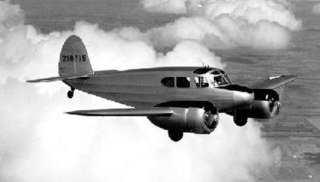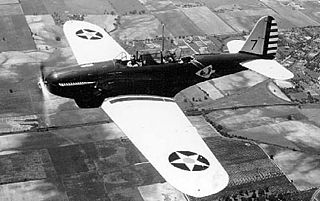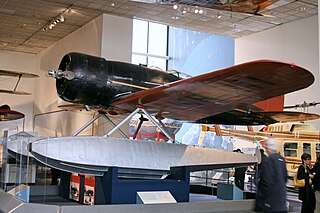
The Curtiss Falcon was a family of military biplane aircraft built by the American aircraft manufacturer Curtiss Aeroplane and Motor Company during the 1920s. Most saw service as part of the United States Army Air Corps as observation aircraft with the designations O-1 and O-11, or as the attack aircraft designated the A-3 Falcon.
The Lockheed Model 10 Electra is an American twin-engined, all-metal monoplane airliner developed by the Lockheed Aircraft Corporation, which was produced primarily in the 1930s to compete with the Boeing 247 and Douglas DC-2. The type gained considerable fame as one was flown by Amelia Earhart and Fred Noonan on their ill-fated around-the-world expedition in 1937.

The Curtiss P-36 Hawk, also known as the Curtiss Hawk Model 75, is an American-designed and built fighter aircraft of the 1930s and 40s. A contemporary of the Hawker Hurricane and Messerschmitt Bf 109, it was one of the first of a new generation of combat aircraft—a sleek monoplane design with a retractable undercarriage making extensive use of metal in its construction.

The Douglas A-20 Havoc is an American light bomber, attack aircraft, night intruder, night fighter, and reconnaissance aircraft of World War II.

The Lockheed Model 18 Lodestar is an American passenger transport aircraft of the World War II era, developed as part of the Model 10 Electra family, specifically from the Lockheed Model 14 Super Electra.

The North American Aviation T-6 Texan is an American single-engined advanced trainer aircraft used to train pilots of the United States Army Air Forces (USAAF), United States Air Force (USAF), United States Navy, Royal Air Force, Royal Canadian Air Force and other air forces of the British Commonwealth during World War II and into the 1970s.

The Douglas Y1B-7 was a 1930s American bomber aircraft. It was the first US monoplane given the B- 'bomber' designation. The monoplane was more practical and less expensive than the biplane, and the United States Army Air Corps chose to experiment with monoplanes for this reason. At the time the XB-7 was ordered, it was being tested by Douglas Aircraft as an observational plane.

The Cessna AT-17 Bobcat or Cessna Crane is a twin-engine advanced trainer aircraft designed and made in the United States, and used during World War II to bridge the gap between single-engine trainers and larger multi-engine combat aircraft. The commercial version was the Model T-50, from which the military versions were developed. Additional versions and names include the AT-8 trainer, UC-78 transport and bomber, and the Crane Mk.I in Canadian service.

The Beechcraft Model 18 is a 6- to 11-seat, twin-engined, low-wing, tailwheel light aircraft manufactured by the Beech Aircraft Corporation of Wichita, Kansas. Continuously produced from 1937 to November 1969, over 9,000 were built, making it one of the world's most widely used light aircraft. Sold worldwide as a civilian executive, utility, cargo aircraft, and passenger airliner on tailwheels, nosewheels, skis, or floats, it was also used as a military aircraft.

The North American Aviation NA-16 is the first trainer aircraft built by North American Aviation, and was the beginning of a line of closely related North American trainer aircraft that would eventually number more than 17,000 examples, notably the T-6 Texan family.

The Grumman FF "Fifi" is an American biplane fighter aircraft operated by the United States Navy during the 1930s. It was the first carrier aircraft with retractable landing gear. It was produced under licence in Canada and known as the Goblin in Canadian service and Delfín in Spanish service.

The Douglas A-33 was an American attack aircraft built in small numbers during World War II. It was an updated version of the Northrop A-17, with a more powerful engine and an increased bomb load. While the A-33 was intended initially for the export market, the entire production run was taken up by the United States Army Air Corps.

The Northrop Gamma is a single-engine all-metal monoplane cargo aircraft used in the 1930s. Towards the end of its service life, it was developed into the A-17 light bomber.

The Consolidated P-30 (PB-2) was a 1930s United States two-seat fighter aircraft. An attack version called the A-11 was also built, along with 2 Y1P-25 prototypes and YP-27, Y1P-28, and XP-33 proposals. The P-30 is significant for being the first fighter in United States Army Air Corps service to have retractable landing gear, an enclosed and heated cockpit for the pilot, and an exhaust-driven turbo-supercharger for altitude operation.

The Lockheed Model 8 Sirius is a single-engined, propeller-driven monoplane designed and built by Jack Northrop and Gerard Vultee while they were engineers at Lockheed in 1929, at the request of Charles Lindbergh. Two versions of the same basic design were built for the United States Air Force, one made largely of wood with a fixed landing gear, and one with a metal skin and retractable landing gear, designated Y1C-25 and Y1C-23, respectively. Its basic role was intended to be as a utility transport.

The Douglas O-2 was a 1920s American observation aircraft built by the Douglas Aircraft Company, powered by the Liberty engine of WW1 fame, with some later variants using other engines. It was developed into several versions, with 879 being produced in total. It was used in combat by the Chinese Air Force in the 1930s and also was the basis for a successful mailplane version.
The British Purchasing Commission was a United Kingdom organisation of the Second World War. Also known at some time as the "Anglo-French Purchasing Board", it was based in New York City, where it arranged the production and purchase of armaments from North American manufacturers. After the 1940 French Surrender it became the 'British Purchasing Commission'. The Commission was also responsible for taking over orders that had originally been placed by France, Belgium, and later by Norway, after the capitulation of those countries.

The Consolidated O-17 Courier was an observation and training aircraft used by the United States National Guard.

The Northrop Delta was an American single-engined passenger transport aircraft of the 1930s. Closely related to Northrop's Gamma mail plane, 13 were produced by the Northrop Corporation, followed by 19 aircraft built under license by Canadian Vickers Limited.

The Vought V-141 was a prototype American single-seat fighter aircraft of the 1930s. It was a development of the unsuccessful Northrop 3-A design, but was itself a failure, being rejected by the United States Army Air Corps. The sole prototype was sold to the Japanese Army in 1937, but no production followed, with the type proving to be inferior to existing Japanese fighters.






















